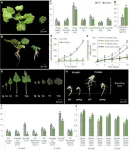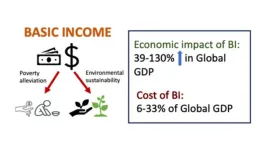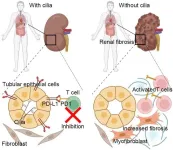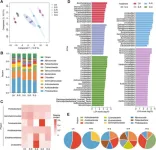(Press-News.org) Unlocking the secrets of nature, a pioneering study has pinpointed a gene mutation with profound implications for plant height and stress tolerance. The discovery lies in the CpDWF5 gene, whose alteration leads to a compact squash plant with a unique resistance to salt stress, marking a leap forward in agricultural science.
In the quest to bolster crop yields and fortify plants against environmental stressors, the delicate interplay of phytohormones stands as a keystone. Yet, our grasp of these genetic levers, particularly those dictating plant stature and resilience to salinity, remains tenuous. Bridging these knowledge gaps is imperative for cultivating crops that can thrive in the face of environmental adversity.
From the Agrifood Campus of International Excellence at the University of Almería, an article (DOI: 10.1093/hr/uhae050) hits the stands in Horticulture Research, illuminating the effects of a mutation in the CpDWF5 gene. This research, published on February 23, 2024, meticulously details the genetic ripples that cascade from a single nucleotide change, influencing the very fabric of squash plant life.
Diving into the genetic depths, the study presents a detailed portrait of the dwfcp squash mutant, wrought by a mutation in the CpDWF5 gene. This alteration chokes the production of brassinosteroids, truncating the plant's stature and prompting a dense, dark foliage. Paradoxically, the same mutation endows the plant with a superior ability to withstand salt stress, hinting at a sophisticated genetic crosstalk between growth hormones and stress adaptation. The findings are a testament to the nuanced relationship between genetic mutations and their multifaceted impact on plant physiology.
Dr. Cecilia Martínez, a pivotal voice in the study, underscores its broader implications, "Our findings bridge gaps in our understanding, offering a genetic roadmap for enhancing crop robustness. This is more than an academic pursuit—it's a step towards nurturing crops that can weather the environmental vagaries, a cornerstone for sustainable agriculture."
The implications of this genetic revelation are far-reaching, beckoning a future where crop breeding is guided by a deeper genetic insight. With the CpDWF5 mutation as a case study, the pathway is paved for developing plants with an innate armor against environmental stress, potentially revolutionizing agricultural practices and fortifying global food security.
###
References
DOI
10.1093/hr/uhae050
Original Source URL
https://doi.org/10.1093/hr/uhae050
Funding information
This work was supported by grants PID2020-118080RB-C21 and P20_00327 funded by the Spanish Ministry of Science and Innovation and the Junta de Andalucía. J.I.-M. and G.C. gratefully acknowledge the FPI and FPU Scholarship Program from the Spanish Ministry of Science and Innovation.
About Horticulture Research
Horticulture Research is an open access journal of Nanjing Agricultural University and ranked number one in the Horticulture category of the Journal Citation Reports ™ from Clarivate, 2022. The journal is committed to publishing original research articles, reviews, perspectives, comments, correspondence articles and letters to the editor related to all major horticultural plants and disciplines, including biotechnology, breeding, cellular and molecular biology, evolution, genetics, inter-species interactions, physiology, and the origination and domestication of crops.
END
Shrinking statures, growing insights: unraveling the genetic underpinnings of dwarfism in squash
2024-06-07
ELSE PRESS RELEASES FROM THIS DATE:
Fat molecule’s inability to bond with shape-shifting protein in cell’s powerhouse linked to an inherited metabolic disease
2024-06-07
FOR IMMEDIATE RELEASE
By studying mutations in yeast and human cells, Johns Hopkins Medicine scientists say they have found that biochemical bonds between fats and proteins in the mitochondrion, the cell’s powerhouse, play a crucial role in how our cells produce energy.
The study results, published June 5 in The EMBO Journal, shed new light, researchers say, on the way the altered mitochondrial membranes found in people with metabolic diseases such as Barth syndrome, a rare genetic disorder that weakens the heart, fail to enable cellular power production.
Metabolism is a set of biochemical reactions central to making energy to fuel life and to getting rid of substances a body no ...
Wildfire smoke reached 99% of U.S. lakes in 2019-2021
2024-06-07
Where there’s smoke, there’s not necessarily fire.
Wildfire smoke, sometimes drifting from hundreds of miles away, touched nearly every lake in North America for at least one day per year from 2019 to 2021, according to a study from the University of California, Davis.
Even more significantly, the study, published in the journal Global Change Biology, found that 89% of the lakes in North America experienced smoke for more than 30 days during each of those three years of intense wildfire activity.
“That was surprising, even ...
Basic income can double global GDP while reducing carbon emissions
2024-06-07
Giving a regular cash payment to the entire world population has the potential to increase global gross domestic product (GDP) by 130%, according to a new analysis published June 7 in the journal Cell Reports Sustainability. Researchers suggest that charging carbon emitters with an emission tax could help fund such basic income program while reducing environmental degradation.
“We are proposing that if we can couple basic income with environmental protection, we can save two birds with one stone,” says first author U. Rashid Sumaila of the University of British Columbia in Vancouver.
Sumaila has been working on ending harmful fishery subsidies worldwide, but many people who rely ...
The rate, nature and transmission of mitochondrial DNA mutations in humans
2024-06-07
A new study from deCODE genetics uses pedigrees and sequence data from 64,806 Icelanders to shed light on the rate and nature of mutations in mitochondrial DNA (mtDNA) and the peculiar dynamics of its maternal transmission.
In a paper published today in Cell, scientists from deCODE genetics, a subsidiary of Amgen, present the largest study to date of germline mtDNA mutations in humans and their transmission across 116,663 mother-child pairs. The study documents the astonishing extent of hypermutability at some positions in mtDNA, including the well-known deleterious A>G mutation at position 3243 which causes the MELAS syndrome. The mutation ...
Prevalence of iron deficiency using 3 definitions among women in the US and Canada
2024-06-07
About The Study: Three definitions of iron deficiency were associated with significantly different prevalence of iron deficiency in women, regardless of self-reported age, pregnancy, or race and ethnicity. Using higher serum ferritin thresholds to define iron deficiency could lead to diagnosis and treatment of more women with iron deficiency and greater reduction of related morbidity.
Corresponding Author: To contact the corresponding author, James C. Barton, M.D., email bartonjames336@gmail.com.
To access the embargoed study: ...
Bariatric metabolic surgery vs glucagon-like peptide-1 receptor agonists and mortality
2024-06-07
About The Study: Bariatric metabolic surgery was associated with greater reduced mortality compared with first-generation glucagon-like peptide-1 receptor agonists (GLP-1RAs) among individuals with a diabetes duration of 10 years or less, mediated via greater weight loss in this cohort study. No differences in the risk for mortality were observed between the treatment modalities among individuals with a longer duration of diabetes, nor in the occurrence of nonfatal major adverse cardiovascular events among all patients.
Corresponding Author: To contact the corresponding author, ...
Primary cilia restrict autoinflammation by mediating PD-L1 expression
2024-06-07
Ciliopathies are multisystem disorders characterized by the dysfunction of motile and/or non-motile cilia, which show common clinical manifestations of ciliopathies include retinal degeneration, mental retardation, renal abnormality, obesity, and skeletal dysplasia. Fibrosis of vital organs, characterized by the extensive deposition of extracellular matrix components, represents another complication frequently observed in patients and animal models of ciliopathies. However, the precise mechanism that connects ciliary defects to fibrosis remains largely elusive.
The recent study led by Dr. Min Liu (Haihe Laboratory of Cell Ecosystem) and Dr. Yunfan Yang (Shandong University) showed ...
Roots of resistance: unveiling the soil-saving secrets of grafting
2024-06-07
Grafting, an age-old horticultural technique, has been revealed as a powerful tool against soil-borne diseases like crown gall. New research uncovers how the composition of root exudates changes when plants are grafted onto resistant rootstocks, creating a defensive mechanism that reduces the prevalence of pathogenic Agrobacterium.
Crown gall disease, a destructive plant ailment caused by Agrobacterium, has long plagued agriculture, leading to significant crop losses. Traditional control methods have proven inadequate, highlighting an urgent need for innovative solutions. Given the pervasive impact of this disease and the limitations ...
Insilico Medicine Founder and CEO Alex Zhavoronkov, PhD talks about AI and robotics in healthcare breakthroughs in following conferences
2024-06-07
Alex Zhavoronkov, PhD, founder and co-CEO of Insilico Medicine (“Insilico”), a clinical-stage generative artificial intelligence (AI)-driven drug discovery company, will be attending a series of meetings in the following week, where he will be discussing bioscience innovations powered by AI and robotics.
More information about the events is listed as follows:
[1] London Tech Week 2024
Fireside Chat: The Forefront of AI Innovation in Health Tech
Time: Monday, 10th June 15:55 - 16:15 (UK time)
Location: London Olympia, Main Stage
London Tech Week is the global tech ecosystem aiming to accelerate the infinite cycle of tech innovation, which brings together the innovators ...
New: Classification Criteria for Hand OA
2024-06-07
Hand osteoarthritis mainly affects the distal interphalangeal, proximal interphalangeal, and thumb base joints,1 leading to joint pain, aching, and stiffness. Criteria developed by the American College of Rheumatology (ACR) in 1990 are useful, but they cannot distinguish between interphalangeal or thumb base disease, and this is important since these two phenotypes may require different treatment strategies.
To address this, EULAR and a team of leading experts in the field set out to develop new classification criteria sets that include radiographic features. Early phases of the project used observational data to identify self-reported, ...









